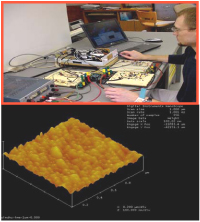Intelligent Quality Sensors for Safe Food Products
Investigators
Suranjan Panigrahi, Catherine Logue, Jacob Glower
Research Statement/Motivation
Ensuring safe food products for the public is a critical need of the USA. Unsafe and contaminated food products can cause health problems and even death. The associated economical and social impacts are huge. There are strong needs for developing intelligent, rapid and portable sensors that can alret consumer about bacterial contamination in a food product. Once developed, this system could alert consumers of potential health hazards and enhance safety.
Research Methods
We adopted a novel approach to address this biological problem. Our model food product is packaged beef (biological tissue). Growth of bacteria (biological organism) in meat is a complex biological phenomenon. Our strategy is to develop an artifiicial olfactory sensor or sensors that would sense the volatitle organic compounds associated with the bacterial contaminations. We are adopting a robust approace by using a SENSOR fusion technique to address this cojmplex problem. WE have successfully built and integrated different olfactory sensing system and laso evaluated commercial electronic noses. Our integrated appropach involves novel sensing material, electronics and associated pattern recognition techniques.
Major Results and Conclusions

Several different electronic nose systems, intelligent Artificial Nose (IAN), have been developed. Conducting polymer-based commercial system has been evaluated for Salmonella contamination. Other novel approaches based on infrared, porphyrin and metal oxide sensors have been and are being evaluated. So far, the developed systems have show accuracies of more than 85-90% in classifying contaminated products from uncontaminated ones. The picture shows one of the integrated sensor systems during testing. The other photo shoes the AFM picture of metal oxide during its evaluation as a sensor.


